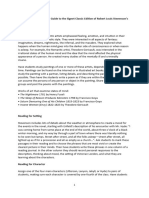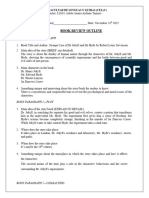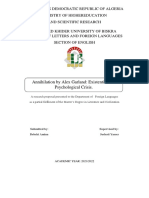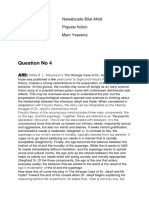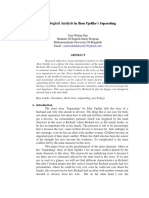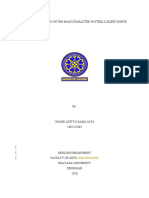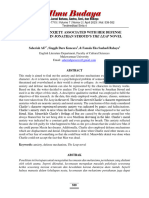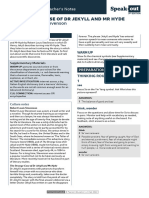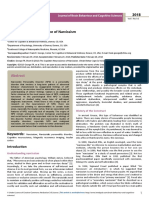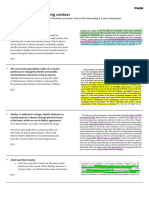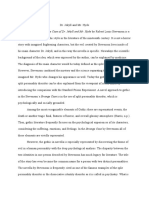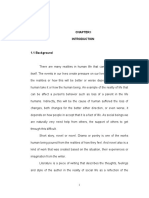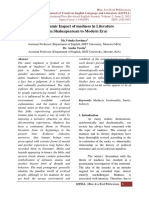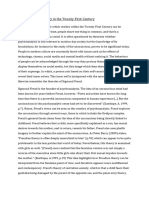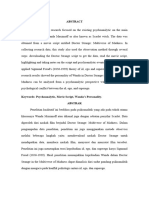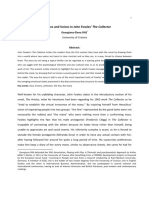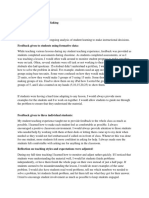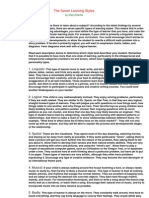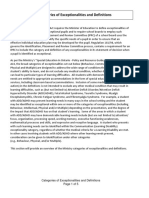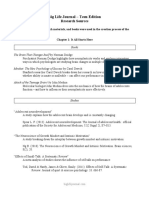3567 7418 1 PB
3567 7418 1 PB
Uploaded by
Quynh Anh TranCopyright:
Available Formats
3567 7418 1 PB
3567 7418 1 PB
Uploaded by
Quynh Anh TranOriginal Title
Copyright
Available Formats
Share this document
Did you find this document useful?
Is this content inappropriate?
Copyright:
Available Formats
3567 7418 1 PB
3567 7418 1 PB
Uploaded by
Quynh Anh TranCopyright:
Available Formats
2nd English Language and Literature International Conference (ELLiC) Electronic ISSN: 2579-7263
Proceedings – (ELLiC Proceedings Vol. 2, 2018) CD-ROM ISSN: 2579-7549
DISSOCIATIVE IDENTITY DISORDER REFLECTED IN FREDERICK
CLEGG’S CHARACTER IN THE COLLECTORS NOVEL
Janitra Asia1*), Samanik2)
Faculty of Arts and Education, Universitas Teknokrat Indonesia, Bandar Lampung
Indonesia
*janitraasiaasia@gmail.com ,*samanaik@.teknokrat.ac.id
ABSTRACT
This paper discusses dissociative identity disorder as seen in John Flowless’ novel
entitled The Collectors. The main purpose of this research is to reveal the causes
of dissociative identity disorder and the symptoms of dissociative identity disorder
in the novel. The writer focuses of the main character who named Frederick
Clegg. The writer arranges the literary review by discussing about theory and
approach. The theory that is used dissociative identity disorder by Pierre Janet.
Dissociative identity disorder is characterized by the presence in one individual of
two or more alternative personality states (alters). For such individuals, the
memory representation of a particular event can have full episodic, auto noetic
status for one alter, while having the status of knowledge or even being
inaccessible to a second alter this analysis applied qualitative and library research
to depict clearly about the problem by using the words. The result of this analysis
shows some causes and symptoms that exist in the novel. For the causes it was
started from capacity for dissociation, traumatic experiences, perpetuating factors.
Meanwhile for the symptoms are start from memory loss (amnesia), mental health
problems, such as depression, anxiety, and suicidal thoughts and behaviors. The
writer hope that by conducting this research it can be use full for the future reader
that are interested in the same theory.
Keywords: The Collectors, dissociative identity disorder, cause, symptoms
Introduction we can see understand the human behavior
Psychology is truly the study of all behavior more deep.
and mental process over the entire life spend There is a very strong correlation
.Psychology is the study of human and between literature and psychology for the
animal behavior normal and abnormal fact that both of them deal with human
behavior conscious and unconscious beings and their reactions, perceptions of the
influence of behavior, and behavior from the world, miseries, wishes, desires, fears,
conception to the dead. Witig (2001, p. 9). conflicts and reconciliations; individual and
From that quotation, it is known that social concerns, by means of varied
psychology is the study that relates human’s concepts, methods, and approaches. Clearly,
minds and behavior which concerned about literature enables individuals to know and
how human can work, behave or interact in question their identities by raising
the situations that they are in. Psychology is consciousness and awareness. It is to be
also the science that studies the human noted that man and existence have always
behavior and mental process that involves been fundamental elements in most scientific
science in order to identify the disease and studies, fine arts and literature (Goksen Aras,
categorized it with some term. Through this, 2014).
DISSOCIATIVE IDENTITY DISORDER REFLECTED IN FREDERICK CLEGG’S CHARACTER …… [ 424 ]
Janitra Asia, Samanik
2nd English Language and Literature International Conference (ELLiC) Electronic ISSN: 2579-7263
Proceedings – (ELLiC Proceedings Vol. 2, 2018) CD-ROM ISSN: 2579-7549
The novel is a debut novel of John tells about how Ferdinand Clegg tormented
Fowless released in 1963. It tells the reader by this illness started from he cannot handle
about the psychological problem that the himself, and he unconscious what he done.
main character has. The main character is By this novel, the writer intended to analyze
Frederick Clegg. He is a man in his mid-20s the psychological issue of Frederick Clegg as
who grows obsessed with Miranda Grey, a the main character. The use of this analysis is
beautiful teenager whom he watches from to know and to observe the behavior of the
afar. He takes the steps necessary to kidnap main character about the disease that he has
Miranda, though at the time he tells himself and able to describe how Dissociative
that he is not necessarily preparing to abduct Identity Disorder happens in the character. In
her. Clegg buys a secluded house in the this analysis the writer will focus in two
country and readies a small basement room things, first is about the causes of
as an inescapable cell; he also buys a van Dissociative Identity Disorder and the
with which to follow and snatch Miranda. second is about the symptoms of
Miranda is alternately kind to Clegg and Dissociative Identity Disorder and how it is
exasperated with him, now conciliatory and describe in the novel.
now furious. She desperately wants to be set
free. While at times she feels defeated, by 1. Research Question
the end of her narration she is full of life and According to the background of the
ready to experience the world outside. Her study which has been elaborated previously,
section ends as she descends further into the writer formulates the problem into:
sickness, beginning to rave and worrying that a. What are the causes that make Frederick
she will die. Clegg reveals that he never got Clegg suffers from Dissociative Identity
a doctor for Miranda and that, after an Disorder (DID)?
agonizing several days of severe pneumonia, b. What are the symptoms that make
Miranda died. Clegg contemplates killing Frederick Clegg suffers from
himself, thus lending their story have a Dissociative Identity Disorder (DID)?
tragically beautiful ending, much like the
conclusion of Romeo and Juliet. However, 2. Research Objective
Clegg has a change of heart. He buries From the research question above,
Miranda without much emotion and sets his the objective of this research are:
sights on a new victim, one who will be a. To reveal the causes that make Frederick
more pliable once captured. Clegg Suffers from Dissociative Identity
From the summary above it can be Disorder (DID)
seen that the main character, Frederick Clegg b. To reveal the symptoms that make
has Mental Disorder. He suffers Dissociative Frederick Clegg from Dissociative
Identity Disorder (DID) or previously known Identity Disorder (DID)
as Multiple Personality Disorder (MPD),
where the person who suffers of this illness 3. Research Uses
has two or more personalities within one There are two uses of study,
body. In this case Frederick Clegg as the theoretical use and practical use.
main characters in the novel portrayed that
he is the one who suffers from it, he has a 4. First Theoretical Use
strange behavior and always thought that he Theoretically, this research is
is just like the other normal people but actual expected to support and to contribute the
not, he has more than personality. field of literary study especially in a novel.
Sometimes he seems fine, good, but So it will be advantageous for the readers
sometimes he is mean and sometimes he who are interested in novel and the topic of
look like a frustration guy. This novel also discussion. Hopefully, this research is able to
DISSOCIATIVE IDENTITY DISORDER REFLECTED IN FREDERICK CLEGG’S CHARACTER …… [ 425 ]
Janitra Asia, Samanik
2nd English Language and Literature International Conference (ELLiC) Electronic ISSN: 2579-7263
Proceedings – (ELLiC Proceedings Vol. 2, 2018) CD-ROM ISSN: 2579-7549
enrich the reader knowledge and to give brief adapted in the novel. One of common
information and understanding about problems is psychological problem. The
Dissociative Identity Disorder (DID) issue writer attempted to portray the main
through John Fowless’ The Collectors. character psychological problem by
identifying the intrinsic elements (plot,
5. Second Practical Use character and setting). The novel talked
Practically, this research is to give about the main character that was Dr. Jekyll.
information about Dissociative Identity This paper also used the psychoanalysis
Disorder (DID) in the novel. This research is theory by Sigmund Freud in order to find the
expected to be reference for reader or causes of the main character’s psychological
researcher who needs information about how problem. The writer found that the main
the content of the novel according to the DID character’s psychological disorder that he
theory is and how to apply the theory to their has two personalities. In general
relevant research. psychological field, the psychological
disorder that suffered by the character, it is
6. Research Scope referred into Dissociative Identity Disorder.
Based on the research question, the The second, Nina’s Dissociative
writer focuses on analyzing what are the Identity Disorder in Aronofsky’s Movie
causes that make the character suffer mental Black Swan: a semiotic analysis by Linda
disorder (Dissociative Identity Disorder) and Sugesti.
the symptoms of becoming transgender as This research, therefore aims to
seen in Frederick Clegg character. Thus, the interpret the meaning of signs that represent
approach and the theory used in this research Nina’s dissociative identity disorder in Black
are psychology studies approach and Swan. This research employs semiotic theory
Sigmund Freud theory. by Peirce. Semiotics is the study of signs.
Everything can be signs while it is
7. Theoretical Framework interpreted as a sign. According to Peirce,
The previous studies are related to sign is divided into three: icon, index and
the topic discussed and become as the symbol. Dissociative identity disorder
writer’s references and guidelines in concept is also applies to find in the scenes
constructing this research. In order to that indicate Nina’s dissociative identity
understand and comprehend the discussion disorder.
of A Psychological Analysis of Dissociative The result of this research found that
Identity Disorder of Frederick Clegg in John there are three modes of signs in Black Swan.
Fowelss’ The Collectors, the writer looks at Those three modes of signs show that Black
a certain study previously done by other Swan tells about Nina’s Dissociative identity
researchers. Here, the writer found 5 disorder. Nina’s dissociative identity
previous studies that could help the writer to disorder signs portray three symptoms of
do the research. dissociative identity disorder which come
The first is Analysis of Dissociative from Nina’s appearance changes, Nina’s
Identity Disorder in R. L. Stevenson’s The behavior changes, and hallucinations.
Strange Case of Dr. Jekyll and Mr. Hyde” by The third, The Main Character’s
Siti Maesyah. Multiple Personality in Daniel Keyes’ The
This thesis was written in 2016. The Minds of Billy Milligan by Faiqothul Latifah.
object in this research is a fiction prose that This thesis was written on 2008 this paper
entitled The Strange Case of Dr. Jekyll and emphasizes to analyze the forms of
Mr. Hyde (1991). It was written by Robert psychological conflicts of Billy Milligan, the
Louis Stevenson. Like in the human social main character of The Minds of Billy
life, there is also a problem or issue that was Milligan, it is causes and effects to Billy’s
DISSOCIATIVE IDENTITY DISORDER REFLECTED IN FREDERICK CLEGG’S CHARACTER …… [ 426 ]
Janitra Asia, Samanik
2nd English Language and Literature International Conference (ELLiC) Electronic ISSN: 2579-7263
Proceedings – (ELLiC Proceedings Vol. 2, 2018) CD-ROM ISSN: 2579-7549
personality and behavior. In the second part the main character of Sidney Sheldon's novel
of analysis, we also analyze kinds of Billy’s Tell Me Your Dreams. This thesis uses the
personalities. This part presents and analyzes method of literature and using a
10 of the most dominant from 24 psychological approach with the theory of
personalities which Billy has. Dissociative Identity Disorder (DID)
As the result of this analysis that Davison and Nale. The intrinsic aspects
emphasize to analyze the kinds of Billy’s analyzed are character, characterization, and
personalities by using Jung’s theory conflict. Such intrinsic aspects are used to
conclude that from 10 of 24 personalities support the overall analysis. Meanwhile, the
which are being analyzed by the researcher, DID theory is used to analyze the extrinsic
we find only three types of personality aspect, i.e., the psychology of characters or
among them, introversion thinking, characters in the story.
introversion feeling and extroversion feeling. And the results of novel Tell Me Your
This study also proves that child abuses Dreams are as follows; based on intrinsic
which are experienced by Billy is the most analysis can be expressed that the main
responsible thing to all the entire of Bily’s character is a beautiful woman, but she hates
psychological conflicts and also his Multiple her appearance. Social status of the main
Personality. character is a smart girl who gets scholarship
The Fourth, Dissociative Identity and reliable in his work. The social status of
Disorder of Main Character in Syibil Novel the main character is a child who is from the
By Flora R.S Based On Psychological family of world-renowned surgeons. The
Perspective. By Rizky Milani Pratama, S.S, results of external analysis in the novel Tell
M.Pd. Me Your Dreams shows that the conflict is
This thesis was written on September the main character experienced traumatic
2016, this paper intends to find out the experience due to rape committed by his
characterization of the sixteen personalities biological father. As a result of his traumatic
and psychological problems in that novel, in experience, the main character experienced
this case, dissociative identity disorder. The multiple personalities. Based on the analysis
writer wants to know about the symptom, the of the psychological approach (DID), DID
causes, and the treatment of dissociative occurs when childhood is caused by severe
identity disorder that found in Sybil novel. physical or sexual abuse and this results in
Sybil as the main character suffers from dissociation and the formation of other
dissociative identity disorder because she got personalities as a way to overcome trauma.
physical and sexual abuse from his mother The solution of the main character to
and she has no one to share and solve her overcome the conflict that occurs against
problems. It forces her to get another him is to create multiple personalities that
solution by making other personalities to are contrary to his personality, such as being
share her problems. Suffering dissociative a killer and loving art.
identity disorder makes her losing her time. Generally, there are some approaches
She does not know what she has done and that are used in analyzing literary works,
what she told about until she meet with Dr. such as structuralism approach,
Wilbur, the psychiatrist who give her psychological approach, sociological
psychotherapy to bend all her personalities. approach and genetic structuralism approach
The fifth, Dissociative Identity to analyze an object. By some of these
Disorder of Ashley Patterson as the Main approaches, the writer chooses Psychological
Character in Sidney Sheldon’s Tell Me Your approach because this approach is more
Dreams by Safira Ambar Sari. effective with the research question and in
This thesis was written on 2013 this answering the research question.
thesis discusses the psychological conflict of
DISSOCIATIVE IDENTITY DISORDER REFLECTED IN FREDERICK CLEGG’S CHARACTER …… [ 427 ]
Janitra Asia, Samanik
2nd English Language and Literature International Conference (ELLiC) Electronic ISSN: 2579-7263
Proceedings – (ELLiC Proceedings Vol. 2, 2018) CD-ROM ISSN: 2579-7549
“Psychology is generally concerned unstable to maintain his mood and behavior
with studying the mind, the brain and the when he meets somebody. Clegg shows the
human behavior.” Psychological approach characteristic as a person who suffers of
assumes that many disorders result from DID. The personality that appear in the
mental, behavioral, and social factors, such person who suffers DID can be various, each
as personal experiences, traumas, conflicts, of them has its own characteristics just like
and environmental conditions. Psychological the normal people, they have they own
approach can be fascinating and rewarding. preferences, abilities and skill and interest in
Novel can be analyzed by psychology some aspect that they like.
approach to knowing about the character’s The definition of DID above gives
psychological problem.” (Ramaraju 2012, p. the writer more understanding in analyzing
2) the object that the writer has choose earlier.
The main issue that the writer wants to
8. The Dissociation Theory discuss is about DID where the character of
Dissociation is the core feature of the this novel suffer this psychology because his
dissociative disorders. Furthermore, trauma in the past.
dissociative experiences are among the DID is not something that is caused
diagnostic criteria for acute stress disorder by birth congenital. If we look deeper to the
(ASD) and post-traumatic stress disorder definition that already mentioned earlier if
(PTSD) as well as borderline personality DID developmental process underlying
disorder. It has been linked to traumatic mental functioning. Mental disorders are
experiences and seems to be an important usually associated with significant distress in
predictor for poor treatment response and social, occupational, or other important
high relapse rates, at least in patients with activities.
panic and obsessive-compulsive disorders. In As the writer has explained in the
the dissociation theory, there are 4 types of background of the study also Dissociative
dissociations those are: Dissociative Identity Disorder (DID) is the person that has
Amnesia, Dissociative Identity Disorder, more than one personality. Dissociative
Dissociative Fugue and Depersonalization. Identity Disorder is not happening by itself,
In this case the main character suffers from there is several causes also that make the
Dissociative Identity Disorder. reason who someone suffers Dissociative
Identity Disorder (DID). And the symptoms
9. Dissociative Identity Disorder are also shown by someone that identified as
Diagnostic and Statistical Manual of Dissociative Identity Disorder (DID).
Mental Disorder (DSM-5) defines mental According to Richard Kluft, there are
disorder is “...a syndrome characterized by 4 main earlier causes of Dissociative Identity
clinically significant disturbance in an Disorder (DID) sense, which are:
individual's cognitive, emotion regulation, or 1. The capacity for dissociation.
behavior that reflects a dysfunction in the 2. Precipitating traumatic experiences that
psychological, biological, or developmental overwhelm the child’s non-dissociative
process underlying mental functioning. coping capacity.
Mental disorders are usually associated with 3. Specific psychological structuring of the
significant distress in social, occupational, or DID alternate personalities.
other important activities.” From that quote, 4. Perpetuating factors such as lack of
it is known that a person can be categorized soothing and restorative experiences,
mentally disorder when he or she suffers which necessitate individuals to find their
emotionally and mentally disturbed. own ways of moderating distress.
In the novel, Frederick Cleg who So from all the quotation, it is known
suffers DID has a mental trouble and that there is relation between childhood
DISSOCIATIVE IDENTITY DISORDER REFLECTED IN FREDERICK CLEGG’S CHARACTER …… [ 428 ]
Janitra Asia, Samanik
2nd English Language and Literature International Conference (ELLiC) Electronic ISSN: 2579-7263
Proceedings – (ELLiC Proceedings Vol. 2, 2018) CD-ROM ISSN: 2579-7549
events that become the reason people suffers whopper. But he’d had a stroke. They
from DID. The abuse and other stuffs make got him home, but he never said another
this people tormented and splitting the word or properly recognize any of us
personality in order to out from that again.” (Fowless, 1963, p. 3)
situation. And there is several symptoms also So from all the quotation, it is known
that shown by someone that identified as that there is relation between childhood
Dissociative Identity Disorder. According to events that become the reason people suffers
(DSM 5), there are seven main earlier from DID. The abuse and other stuffs that
symptoms of Dissociative Identity Disorder make this people tormented and splitting the
(DID) sense, which are: personality in order to out from that
1. Memory loss (amnesia) of certain time situation.
periods, events, people and personal And here the sample analysis of
information symptoms.
2. A sense of being detached from yourself
and your emotions “She was like all women, she had a one-
track mind. I never respected her again.
3. A perception of the people and things It left me angry for days. Because I could
around you as distorted and unreal do it. The photographs (the day I gave
4. A blurred sense of identity her the pad), I used to look at them
5. Significant stress or problems in your sometimes. I could take my time with
relationships, work or other important them. They didn't talk back at me.
areas of your life (Fowless, 1963, p. 49)”
6. Inability to cope well with emotional or
The symptoms of the Dissociative
professional stress
identity disorder (DID) is By understanding
7. Mental health problems, such as
other symptoms above, mental health
depression, anxiety, and suicidal
problems, such as depression, anxiety, and
thoughts and behaviors.
suicidal thoughts and behaviors.
In the simple way, the main causes of
dissociative identity disorder (DID) itself is
Methodology
because of someone who has a deeper
The writer use qualitative and library study
traumatic in the past. And the symptoms of
to support the writer’s research. From
the Dissociative identity disorder (DID) is by
internet research, the writer browsed some
understanding other symptoms above, mental
journals and articles then figured out some
health problems, such as depression, anxiety,
theories from some books related to the
and suicidal thoughts and behaviors.
research. The writer uses the qualitative
And here the sample analysis of
method to explore the behavior, perspectives,
cause:
experiences, and feelings of people and
“My father was killed driving. I was two/ emphasize the understanding of these
that was in 1937. he was drunk, but Aunt elements.
Annie always said it was my mother that
drove him to drink. They never told me 1. Data and Data Source
what really happened, but she went off Data is important element to support
soon after and left me with Aunt Annie,
the writer in doing research; data are factual
she only wanted an easy time.” (Fowless,
1963, p. 3) information, information often in the form
experiments or survey, used as a basic for
“Uncle Dick died when I was fifteen. making calculating or drawing conclusion.
That was 1950. we went up to Tring By this data, the writer can complete this
Reservoir to fish, as usual I went off with research to prove the evidence about this
my net and stuff. When I got hungry and
research. In this research, the writer has data
came back to ware I left him, there were
a canot of people. I told he’d caught a sources. Data in this research are words,
DISSOCIATIVE IDENTITY DISORDER REFLECTED IN FREDERICK CLEGG’S CHARACTER …… [ 429 ]
Janitra Asia, Samanik
2nd English Language and Literature International Conference (ELLiC) Electronic ISSN: 2579-7263
Proceedings – (ELLiC Proceedings Vol. 2, 2018) CD-ROM ISSN: 2579-7549
quotation, and dialog from novel which concluding stage also has function as the
describe about Dissociative Identity Disorder answer of the research question that the
analysis of the main character in novel by writer has elaborated earlier. The conclusion
John fowless will be putted after those steps earlier have
been done.
2. Data Collecting Technique
In data collecting technique, the Conclusion
writer uses these steps in order to collect the In conclusion, The Collectors novel by John
data that dealing with the discussion, The Fowless, the writer discussed about Someone
data of this study collected from the novel who suffers Psychology Disorder we called
The Collectors by John Fawless. There are it Dissociative Identity Disorder in one of
three steps in collecting data: (1) Reading the character, which is Frederick Clegg, by using
novel; (2) Finding and selecting the function DID Theory the writer found the Cause and
of the main character’s role; (3) Note taking also the symptoms that makes someone
and classifying. suffers Dissociative Identity Disorder, for the
cause they are The capacity for dissociation,
3. Data Analyzing Techniques Precipitating traumatic experiences that
Data analysis is a process of overwhelm the child’s non-dissociative
organizing the data into description, so the coping capacity, Specific psychological
writer could find the theme and the issues. structuring of the DID alternate personalities,
The data which the writer got in data Perpetuating factors such as lack of soothing
collecting technique will be analyzed by and restorative experiences, which
following the stage. Here the writer uses necessitate individuals to find their own
several steps in analyzing the data: ways of moderating distress. And for the
Symptoms there are Memory loss (amnesia)
a. Selecting Stage of certain time periods, events, people and
This stage aims the writer to select personal information, A sense of being
the data whether or not the data that chosen detached from yourself and your emotions, A
is relevant and significant or not with the perception of the people and things around
research. Selecting data also relevant with you as distorted and unreal, A blurred sense
choosing the data whether or not the data is of identity, significant stress or problems in
match with the issue that the writer wants to your relationships, work or other important
analyze. areas of your life. Inability to cope well with
emotional or professional stress can cause
b. Interpreting Stage and Classifying Stage mental health problems, such as depression,
The points of this stage is to anxiety, and suicidal thoughts and behaviors.
interprets the data that been chosen by the
writer and construct how is queer character References
contained in the novel. In this stage, the Witrig. (2001). Grounded Theory Of The
writer uses the theory and the approach that Roots and Emergence of Coaching.
the writer have choose to analyze the Washington: international university of
discussion. Profesional studies.
Aras, Goksen. (2014). Literature in
c. Concluding Stage Psychology-Psychology in Literature.
This is the final stage of the www.sciencedirect.com
analyzing technique. Every data that has Barry, Peter. (1995). Psychnalytic Criticism.
been selected, classified and analyzed will be New York: Manchester University.
concluded after relate it with the explanation
and description toward the issue. The
DISSOCIATIVE IDENTITY DISORDER REFLECTED IN FREDERICK CLEGG’S CHARACTER …… [ 430 ]
Janitra Asia, Samanik
2nd English Language and Literature International Conference (ELLiC) Electronic ISSN: 2579-7263
Proceedings – (ELLiC Proceedings Vol. 2, 2018) CD-ROM ISSN: 2579-7549
Cuddon, J.A. (2013). Dictionary of Literary
Terms and Literary Theory.England:
Blackwell Publisher.
Ramajaru. (2012). Analisis Jurnal Psikologi.
Malang: Univeritas Brawijaya.
Lapsley and Stey. (2011). Psychoanalysis
Definition.Washington: The New
Atlantis.
Braun. (1998). The definition of
Dissociation.New York: New Age
International.
Beyond. (2010). The definition Psychology
by Sigmund Freud. New York: New Age
International.
DSM-IV.1998. Dissocition and dissociative
disorders. edited by Paul F. Dell, John
A. O'Neil.
Richard Kluft.2011.What Cause Disossiative
Identity Disorder. England: Blackwell
Publisher.
Elisabeth Howwle. 2011.The Charateristic
of Dissociative Identity Disorder. New
York : Manchester University.
Gleaves, David H. (1996). The
Sociocognitive Model of Dissociative
Identity Disorder: A Reexamination of
the Evidence.
Diagnostic and Statistical Manual of Mental
Disorder fifth edition (2013).
Dissociative Identity Disorder.
Kothari, C. R. (2004). Research Methology
Method and Technique. New York: New
Age International.
K, Yin Robert. (2011). Qualitative Research
From Start To Finish. New York: The
Guildford Press.
DISSOCIATIVE IDENTITY DISORDER REFLECTED IN FREDERICK CLEGG’S CHARACTER …… [ 431 ]
Janitra Asia, Samanik
You might also like
- Excerpts From A TeacherDocument5 pagesExcerpts From A Teachermarina.martins.rochaNo ratings yet
- Book Review OutlineDocument4 pagesBook Review OutlineSaúl BadilloNo ratings yet
- VaughanBell ThroughAScannerDarklyDocument5 pagesVaughanBell ThroughAScannerDarklyViv BolusNo ratings yet
- The Relationship Between Narcissistic Personality and Violent Behavior As Represented in William Golding's Lord of The FliesDocument13 pagesThe Relationship Between Narcissistic Personality and Violent Behavior As Represented in William Golding's Lord of The FliesMahwa SNo ratings yet
- A Thesis Depression of The Main Character in Sylvia PlathDocument7 pagesA Thesis Depression of The Main Character in Sylvia PlathNur Azizah RahmanNo ratings yet
- Philosophical Interpretation Of: "Strange Case of Dr. Jekyll and Mr. Hyde"Document9 pagesPhilosophical Interpretation Of: "Strange Case of Dr. Jekyll and Mr. Hyde"daleNo ratings yet
- The Conscious Desire Dependon Man Shown by Main Characters in Little Women's Novel The Overview of Cinderella Complex Disorder in LiteratureDocument6 pagesThe Conscious Desire Dependon Man Shown by Main Characters in Little Women's Novel The Overview of Cinderella Complex Disorder in LiteratureInternational Journal of Innovative Science and Research TechnologyNo ratings yet
- IMP To LEARNDocument9 pagesIMP To LEARNYousaf KhanNo ratings yet
- Ender's Game L2 RobertDocument22 pagesEnder's Game L2 RobertRobert SchneiderNo ratings yet
- Stockholm Syndrome Reflected in Andrea Kleine's EdenDocument10 pagesStockholm Syndrome Reflected in Andrea Kleine's EdenFitra Al MutawakilNo ratings yet
- Research Proposal SampleDocument9 pagesResearch Proposal SampleHarzelli MeriemNo ratings yet
- The Analysis of Social Conflict in Officially Death by Rechard PrescottDocument5 pagesThe Analysis of Social Conflict in Officially Death by Rechard PrescottMadi Jordy Poenya 'Ni'No ratings yet
- Ender's Game L1 RobertDocument20 pagesEnder's Game L1 RobertRobert Schneider100% (1)
- Criticism PaperDocument9 pagesCriticism Papermuneeba khanNo ratings yet
- Jeckle and HydeDocument11 pagesJeckle and HydecaitlynpsharpNo ratings yet
- Naseer FatimaDocument5 pagesNaseer FatimaAlmass MazharNo ratings yet
- Psychology (PP)Document4 pagesPsychology (PP)FanstaNo ratings yet
- English Language Essay TopicsDocument6 pagesEnglish Language Essay Topicsafabfoilz100% (2)
- Psychological Analysis in Jhon UpdikeDocument9 pagesPsychological Analysis in Jhon UpdikeYENI WULAN DARINo ratings yet
- Senior PaperDocument6 pagesSenior Paperapi-353782484No ratings yet
- Revision Booklet: Jekyll & HydeDocument31 pagesRevision Booklet: Jekyll & HydeKa ZheNo ratings yet
- Skripsi Adityarama (Edited)Document53 pagesSkripsi Adityarama (Edited)wayan terusNo ratings yet
- Tracing Madness: Impact Factor: 5.225Document6 pagesTracing Madness: Impact Factor: 5.225Naga PakalaNo ratings yet
- Domestic Abuse EssayDocument4 pagesDomestic Abuse Essayrlxaqgnbf100% (2)
- Psychoanalysis of The Main Character in RainbowDocument8 pagesPsychoanalysis of The Main Character in RainbowPuja Ananda Maratus SolichahNo ratings yet
- An Analysis of Dong Bang MinDocument10 pagesAn Analysis of Dong Bang MinAngie CnxpNo ratings yet
- DR Jekyll and MR Hyde ThesisDocument8 pagesDR Jekyll and MR Hyde Thesisuywodgikd100% (1)
- 7487 34381 1 PBDocument14 pages7487 34381 1 PBHermanda OctavianNo ratings yet
- Presentation DraftDocument7 pagesPresentation DraftZahraa QahtanNo ratings yet
- Name: Adam Ghifran Budiman NIM: E1D019005: 1. A. Dr. Henry JekyllDocument4 pagesName: Adam Ghifran Budiman NIM: E1D019005: 1. A. Dr. Henry JekyllAdam GhifranNo ratings yet
- Skripsi Saiki Part 5Document48 pagesSkripsi Saiki Part 5Aji Mukti WasesaNo ratings yet
- The Psychoanalysis of The Gothic ElementDocument43 pagesThe Psychoanalysis of The Gothic ElementZainab HanNo ratings yet
- Is Loneliness A Psychological Dysfunction - A Literary Study of The Phenomenon of LonelinessDocument9 pagesIs Loneliness A Psychological Dysfunction - A Literary Study of The Phenomenon of LonelinessGerardo DamianNo ratings yet
- By Robert Louis Stevenson: The Strange Case of DR Jekyll and MR HydeDocument3 pagesBy Robert Louis Stevenson: The Strange Case of DR Jekyll and MR HydeMaxi ComasNo ratings yet
- The Impostor Revisited EditedDocument12 pagesThe Impostor Revisited Editedtashatemperator100% (1)
- Feminism Issues Analysis in Celie Character Through "The Color Purple" Novel by Alice WalkerDocument15 pagesFeminism Issues Analysis in Celie Character Through "The Color Purple" Novel by Alice WalkerNur Azizah RahmanNo ratings yet
- The Psychoanalysis of The Gothic ElementDocument43 pagesThe Psychoanalysis of The Gothic ElementMido RHNo ratings yet
- Proposal Chapter 1-3Document17 pagesProposal Chapter 1-3Angie CnxpNo ratings yet
- The Cognitive Neuroscience of NarcissismDocument9 pagesThe Cognitive Neuroscience of NarcissismAlex RodriguesNo ratings yet
- Between Apprehension and Appreciation: A Qualitative Psychoanalysis of Thomas Harris The Silence of The LambsDocument5 pagesBetween Apprehension and Appreciation: A Qualitative Psychoanalysis of Thomas Harris The Silence of The LambsIJAR JOURNALNo ratings yet
- Prose Ini yDocument13 pagesProse Ini yRangga Ananta PradanaNo ratings yet
- Jekyll and Hyde Interesting ContextDocument6 pagesJekyll and Hyde Interesting Contextreece.dillon01No ratings yet
- Book Review - Eric R Kandel (2018) - The Disorder Mind - Philip CorrDocument3 pagesBook Review - Eric R Kandel (2018) - The Disorder Mind - Philip CorrAmanie AmanieNo ratings yet
- Okofu Jennifer's Chapter 1 EditedDocument12 pagesOkofu Jennifer's Chapter 1 EditedBilabi JosephNo ratings yet
- DR Jekyllandmr Hyde PDFDocument11 pagesDR Jekyllandmr Hyde PDFSaba AliNo ratings yet
- Freudian Analysis of Somerset MaughamDocument11 pagesFreudian Analysis of Somerset MaughamAleena IftehatNo ratings yet
- Rangga Ananta Pradana - UAS ToLDocument4 pagesRangga Ananta Pradana - UAS ToLRangga Ananta PradanaNo ratings yet
- Intelligence Theories and IssuesDocument40 pagesIntelligence Theories and IssuesDaniel OrdazNo ratings yet
- Psychoanalysis A Comprehensive Guide For UGC NET EnglishDocument6 pagesPsychoanalysis A Comprehensive Guide For UGC NET EnglishRibakar 001No ratings yet
- Edit Pra FinalDocument47 pagesEdit Pra FinalMuhammad RizalNo ratings yet
- 2.Ms - Vrinda Sawhney & Dr. Anshu TeotiaDocument5 pages2.Ms - Vrinda Sawhney & Dr. Anshu TeotiaJefery SungNo ratings yet
- Httpsblogs - Salford.ac - Ukwindows of Opportunitywp Contentuploadssites68202007Theory Practice Psychoanalysis in The 21sDocument5 pagesHttpsblogs - Salford.ac - Ukwindows of Opportunitywp Contentuploadssites68202007Theory Practice Psychoanalysis in The 21shellorachie18No ratings yet
- The Trait Approach To Personality Is One of The Major Theoretical Areas in The Study of PersonalityDocument17 pagesThe Trait Approach To Personality Is One of The Major Theoretical Areas in The Study of PersonalityClaire RoxasNo ratings yet
- Chapter I-VDocument79 pagesChapter I-VAyu100% (1)
- Photography EssayDocument6 pagesPhotography Essayafabidbyx100% (2)
- Wa0006.Document53 pagesWa0006.Lidiah LidiNo ratings yet
- Butterflies and Voices in John Fowles THDocument9 pagesButterflies and Voices in John Fowles THivantodorovic147No ratings yet
- Psychology Final PaperDocument16 pagesPsychology Final Paperapi-391304725No ratings yet
- An Analysis of Kevin's Ego in "Split" Movie (A Psychoanalysis Study)Document6 pagesAn Analysis of Kevin's Ego in "Split" Movie (A Psychoanalysis Study)Hermawan FajrNo ratings yet
- Asertivna KomunikacijaDocument9 pagesAsertivna KomunikacijaMiloš DavitkovićNo ratings yet
- Purposive Communication Reviewer Purposive Communication ReviewerDocument4 pagesPurposive Communication Reviewer Purposive Communication ReviewerMidsy De la CruzNo ratings yet
- Instructional Decision MakingDocument2 pagesInstructional Decision MakingKayla OliverNo ratings yet
- Group 1 - The Psychology of LanguageDocument17 pagesGroup 1 - The Psychology of LanguageReni NabellaNo ratings yet
- Kiare Smart GoalsDocument3 pagesKiare Smart Goalsapi-318027909No ratings yet
- American Psychiatric Association, Susan C. Jenkins - Ethics Primer of The American Psychiatric Association (2001)Document116 pagesAmerican Psychiatric Association, Susan C. Jenkins - Ethics Primer of The American Psychiatric Association (2001)Victor Islas100% (2)
- Case Study "John Rick Corpuz"Document2 pagesCase Study "John Rick Corpuz"sir jjNo ratings yet
- Basic Will Course - Avatar (Star's Edge International)Document15 pagesBasic Will Course - Avatar (Star's Edge International)Marcus Geier100% (2)
- Psychological Contract Turnley-PresentationDocument17 pagesPsychological Contract Turnley-PresentationdedelushNo ratings yet
- Risk Management Prelim Quiz 1Document10 pagesRisk Management Prelim Quiz 1shane50% (2)
- Peer Assessment Form Jarboe Im Elective PnaDocument2 pagesPeer Assessment Form Jarboe Im Elective Pnaapi-610938913No ratings yet
- The Seven Learning StylesDocument2 pagesThe Seven Learning StylesJs ParkNo ratings yet
- Case Record Proforma-NDADocument4 pagesCase Record Proforma-NDASwati Tiwari Life CoachNo ratings yet
- Assessing Self-Regulation: A Guide For Out-Of-School Time Program PractitionersDocument8 pagesAssessing Self-Regulation: A Guide For Out-Of-School Time Program PractitionersLeti MouraNo ratings yet
- Creative Message Strategies: Techniques in Print & Broadcast AdvertisingDocument30 pagesCreative Message Strategies: Techniques in Print & Broadcast Advertisingdeanluv100% (1)
- Pedagogy 3000v2013Document179 pagesPedagogy 3000v2013PverussNo ratings yet
- Ethical Aspects of Nursing Research: BY Mr.B.Ramakrishna, 1St Year, M.SC, NPCC Gitam Institute of Nursing, VishakapatnamDocument38 pagesEthical Aspects of Nursing Research: BY Mr.B.Ramakrishna, 1St Year, M.SC, NPCC Gitam Institute of Nursing, VishakapatnamRamakrishna BadeNo ratings yet
- Addie Report - Sharin 1Document3 pagesAddie Report - Sharin 1api-510028688No ratings yet
- Section 2.7 - Categories of Exceptionalities and Definitions PDFDocument5 pagesSection 2.7 - Categories of Exceptionalities and Definitions PDFAlona Manabat SerratoNo ratings yet
- Communicating Behind Bars: A Guide For Prison Inmates, Family and FriendsDocument29 pagesCommunicating Behind Bars: A Guide For Prison Inmates, Family and FriendsGeorgiana BogdanNo ratings yet
- Safety Culture Assessment in Petrochemical IndustryDocument11 pagesSafety Culture Assessment in Petrochemical IndustryDHRUV SONAGARANo ratings yet
- Neck - Disability.indexDocument3 pagesNeck - Disability.indexAyesha HabibNo ratings yet
- Behavioral Interventions - 2023 - Kamana - Large Scale Evaluation of Staff Training in Programs For Adults WithDocument22 pagesBehavioral Interventions - 2023 - Kamana - Large Scale Evaluation of Staff Training in Programs For Adults WithNBNo ratings yet
- Group 3 Uap ProjectDocument13 pagesGroup 3 Uap Projectapi-725203846No ratings yet
- Synopsis Report On Organic Cosmetics by PCTEDocument10 pagesSynopsis Report On Organic Cosmetics by PCTESingh GurpreetNo ratings yet
- Booklet 9box PDFDocument59 pagesBooklet 9box PDFDaniel Ordoñez100% (1)
- Big Life Journal - Teen Edition Research SourcesDocument5 pagesBig Life Journal - Teen Edition Research SourcesAnna R Zahor0% (2)
- Aljon A. Galas Bsed Filipino 3 Student'S ExpectationDocument6 pagesAljon A. Galas Bsed Filipino 3 Student'S ExpectationAljon Adlaon GalasNo ratings yet
- Banning Non-Essential, Elective Cosmetic Surgery For Teens Under The Age of 18Document4 pagesBanning Non-Essential, Elective Cosmetic Surgery For Teens Under The Age of 18Stefanie KarinaNo ratings yet
- Three Stages of Learning According To VedantaDocument10 pagesThree Stages of Learning According To VedantaSudipta ShawNo ratings yet
